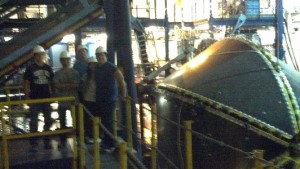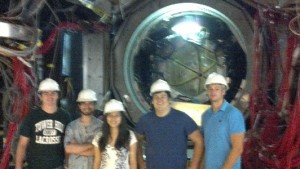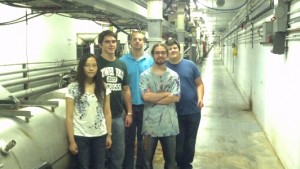A group of five Richmond physics students went on a tour of the Thomas Jefferson National Accelerator Facility (Jefferson Lab or JLab) in Newport News, VA in July. The tour was led by one of the Richmond Physics faculty, Jerry Gilfoyle, whose research is focused on the program in Hall B at JLab. Three of the Richmond students (Keegan Sherman, Liam Murray, and Spencer Bialt) are doing nuclear physics this summer with Dr. Gilfoyle. Jocelyn Xue and Rob Lee also went along. They are doing cosmology research this summer with Ted Bunn.
JLab is built around a mile-long electron accelerator (CEBAF) that can accelerate electrons up to energies of 6 GeV. The beam is then directed into one of four end stations. The group started in Hall B which holds one of the large particle detectors called CLAS. CLAS is a large, spherical, magnetic spectrometer about 10 m in diameter. It surrounds the target so nearly all of the debris from a collision with the electron beam is detected. The goal of the science at JLab is to uncover the secrets of the strong force that binds quarks together to form protons, neutrons, and, in turn, atomic nuclei. That force is described by a theory, quantum chromodynamics (QCD), that has been highly successful at higher energies and should work at JLab energies, but until now the theory has not been solved. With JLab we hope to challenge theory with new data on nucleon and nuclear structure.
The group started in Hall B. The first picture below shows them standing on the forward carriage that holds some of the CLAS components. The main part of the CLAS can be seen to the right.

The second picture below shows the group now at the point where the beam enters the detector. Normally a vacuum pipe carrying the beam would go through the middle of the picture and enter the round opening behind them. In a real experiment, that opening would be filled by a target.

The last shot below shows them later in the accelerator tunnel. The JLab electron beam is accelerated by superconducting cavities that have a rapidly changing electric field and form a racetrack shape about a mile around. Individual electrons injected into the machine can make up to five laps before being extracted and sent into one of the end stations. The shot below shows one of the large cryomodules at lower left that hold the cavities. A string of cryomodules form a long chain that extends down the tunnel behind the group.
